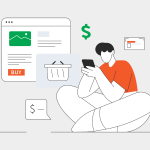Today’s customers expect more than just good service, they want to feel seen, understood, and valued. That’s why personalization is no longer optional; it’s essential. From tailored emails to product recommendations based on past behavior, customized engagement shows your customers you’re paying attention. It builds trust, boosts satisfaction, and keeps people coming back.
But personalization isn’t just about using a name in an email, it’s about creating meaningful, relevant experiences at every touchpoint. In this blog, we’ll explore simple yet powerful ways to customize customer engagement and create a more personal connection that drives loyalty and long-term success.
The Evolution of Customer Engagement Personalization
Customer engagement has undergone a remarkable transformation over the past decade, evolving from simple demographic targeting to sophisticated predictive personalization. As expectations have grown, self customer service has become central to how consumers interact with brands, offering greater control and convenience. Let’s explore this journey and understand what modern customers truly value.
From Demographics to Behavioral Intelligence
Traditional personalization once meant simply addressing customers by name or broadly segmenting them by age or location. Today’s personalized customer experience leverages real-time behavioral data, purchase history, and interaction patterns to anticipate needs before customers even express them.
Rising Consumer Expectations
Today’s consumers expect personalized experiences. It’s no longer a bonus, it’s the baseline. Brands that fail to deliver relevant, tailored interactions risk losing attention and loyalty in an increasingly competitive market.
The Predictive Personalization Revolution
The most significant shift has been toward predictive personalization, using AI and machine learning to anticipate customer needs based on behavioral signals. This proactive approach allows brands to solve problems before they arise and offer solutions just when customers need them most.
Now that we understand how personalization has evolved, let’s examine the foundation needed to build truly personalized experiences in today’s complex marketplace.
Building the Foundation for Personalized Customer Experiences
Creating effective personalization requires more than just technology, it demands a comprehensive strategy built on solid data practices and genuine customer understanding. Here’s how to establish this critical foundation.
Creating a Unified Customer View
Personalization begins with comprehensive customer profiles that capture interactions across all touchpoints. This 360-degree view enables brands to understand the complete customer journey rather than isolated interactions.
Many organizations struggle with self customer service implementation because they lack integrated systems that connect customer data across channels. Implementing the right technology allows businesses to pull together these disparate data sources to create a holistic view of each customer.
Defining Meaningful Personalization Criteria
Not all personalization efforts deliver equal value. Successful businesses identify which elements of the experience matter most to their specific audience. Is it product recommendations? Timing of communications? Special recognition on important dates?
Determining these priorities helps focus resources where they’ll make the biggest impact.
Balancing Automation with Human Connection
While technology enables personalization at scale, maintaining an authentic human element remains crucial. The most effective customer engagement strategies find the sweet spot between automated efficiency and genuine human interaction, knowing when to deploy each for maximum impact.
With these foundational elements in place, you’re ready to explore a strategic framework for customizing engagement in ways that truly resonate with your audience.
Strategic Framework for Customizing Customer Engagement
A systematic approach to personalization ensures your efforts deliver consistent value rather than random moments of relevance. Let’s break down an effective strategic framework.
Identifying Meaningful Personalization Opportunities
The customer journey contains numerous potential personalization touchpoints, but which ones matter? Successful businesses map their customer journeys meticulously to identify high-impact opportunities.
Mapping Critical Journey Touchpoints
Begin by documenting every interaction customers have with your brand, from initial awareness to post-purchase support. Note the customer’s goals, emotions, and pain points at each stage to identify where personalization can make the biggest difference.
Prioritizing High-Impact Initiatives
Not all personalization efforts deliver equal value. Analyze each potential touchpoint to determine which will most significantly improve customer loyalty and drive business growth. The greatest impact often comes from personalizing moments of friction or emotional significance.
Assessing Organizational Readiness
Before implementing personalization initiatives, evaluate whether your organization has the necessary data, technology, and skills. This honest assessment helps you determine where to start and what capabilities you need to develop.
Data-Driven Personalization Techniques
Effective personalization depends on quality data collected and applied ethically. Here’s how to gather and leverage the right information.
Ethical First-Party Data Collection
The most valuable personalization data comes directly from your customers with their knowledge and consent. Develop transparent ways to gather behavioral data, preferences, and feedback that customers willingly share because they understand the value they’ll receive in return.
Behavioral Analytics Implementation
Tracking how customers interact with your digital properties reveals insights that customers themselves might not articulate. Implement analytics that capture browsing patterns, feature usage, and engagement metrics to understand implicit preferences and needs.
Predictive Modeling Capabilities
Advanced personalization uses historical data to anticipate future needs and behaviors. Developing predictive capabilities allows you to proactively address customer needs before they explicitly express them, creating remarkably prescient experiences that feel almost magical.
Cross-Channel Personalization Implementation
Today’s customers expect consistent personalization regardless of how they interact with your brand. Developing a cohesive omnichannel approach is essential.
Omnichannel vs Multichannel Approaches
Multichannel delivers different experiences across different channels, while omnichannel creates a unified experience that flows seamlessly between channels. The latter requires significantly more integration but delivers a much more cohesive personalized customer experience.
Channel-Specific Best Practices
Each channel has unique constraints and opportunities for personalization. Email allows for highly tailored content but limited interactivity, while mobile apps enable contextual, location-based experiences. Develop channel-specific strategies that play to each medium’s strengths.
Creating Seamless Transitions
The most impressive personalization happens when customers move between channels without losing context. Ensure that interactions and information carry over seamlessly when customers switch from web to mobile, or from digital to in-person experiences.
With a strategic framework in place, let’s examine how advanced technologies can take your personalization efforts to new heights.
Advanced Personalization Technologies That Drive Results
Modern personalization depends on sophisticated technologies that can process vast amounts of data quickly and make intelligent decisions in real-time. Here’s how these technologies enhance customer experience.
AI and Machine Learning Applications
Artificial intelligence transforms personalization by enabling hyper-relevant experiences that continuously improve over time.
Conversational AI for Natural Interactions
AI-powered chatbots and virtual assistants have evolved from simple rule-based tools to sophisticated conversation partners. These technologies provide personalized assistance that adapts to customer communication styles and needs, delivering efficiency without sacrificing the human touch.
Predictive Analytics for Anticipatory Service
Predictive algorithms analyze patterns to anticipate customer needs before they arise. This capability allows businesses to proactively offer solutions at precisely the right moment, creating “wow” experiences that feel almost prescient.
Real-Time Decision Engines
The most sophisticated personalization happens instantaneously, with systems that can process countless variables and determine the optimal experience in milliseconds. These real-time decision engines enable dynamic website experiences, instant offer customization, and adaptive customer service responses.
Next-Generation Customer Journey Orchestration
Modern orchestration tools coordinate personalized experiences across multiple touchpoints with remarkable precision.
Event-Triggered Personalization
The most impactful personalization responds to specific customer actions or milestones. Advanced orchestration tools monitor for significant events, like cart abandonment, subscription renewals, or life changes, and trigger perfectly timed, contextually relevant experiences in response.
| Personalization Type | Impact on Customer Engagement | Implementation Complexity | Business Value |
| Basic (Name, Location) | Low-Moderate | Low | Moderate |
| Behavioral (Based on Actions) | High | Medium | High |
| Predictive (Anticipatory) | Very High | High | Very High |
| Contextual (Time/Location) | High | Medium-High | High |
| Emotional Intelligence | Very High | High | Very High |
Adaptive Journey Mapping
Static customer journey maps are giving way to dynamic models that adapt based on real-time customer behavior. These systems continuously optimize the path for each customer, adjusting touchpoints and messaging to match evolving preferences and needs.
By implementing these advanced technologies thoughtfully, businesses can create personalized experiences that genuinely resonate with customers and drive meaningful business results.
Measuring the Impact of Your Personalization Efforts
No personalization initiative is complete without robust measurement to understand its effectiveness and guide ongoing optimization. Tracking the right metrics helps prove ROI and identify opportunities for improvement.
Key Performance Indicators for Personalization
Effective measurement begins with selecting the right metrics that directly connect to business outcomes.
Customer Satisfaction and Sentiment
Measure how personalization impacts customer perceptions through satisfaction scores, sentiment analysis, and direct feedback. These metrics help you understand the emotional impact of your personalization efforts.
Engagement and Interaction Metrics
Track how personalization affects customer behavior through metrics like time on site, pages per visit, feature adoption, and response rates. Increased engagement typically signals that your personalization is resonating with customers.
Conversion and Revenue Attribution
Ultimately, personalization should drive business growth. Measure conversion rates, average order value, repeat purchase frequency, and customer lifetime value to understand the financial impact of your personalization initiatives.
These metrics provide a foundation for continuous testing and optimization of your customer engagement strategies.
Your Personalization Journey Starts Now
Personalizing customer engagement goes beyond using technology, it requires rethinking how you deliver experiences. True personalization builds real connections, turning one-time buyers into loyal advocates. As customer expectations evolve, businesses must continuously refine their approach.
By laying a strong foundation, using smart strategies, embracing the right tools, and tracking results, you can create experiences that truly resonate. At its core, personalization is about making customers feel understood and valued. When that happens, loyalty, trust, and lasting growth naturally follow.
FAQs on Customizing Customer Engagement
1. What’s the difference between customization and personalization?
Customization is user-controlled (customers select preferences themselves), while personalization is system-driven (using data to automatically tailor experiences). Both enhance engagement, but personalization creates more seamless experiences.
2. Which personalization strategies create the highest ROI initially?
Email personalization, product recommendations, and targeted offers based on purchase history typically deliver the quickest returns. These require relatively little technical infrastructure while driving measurable revenue increases.
3. How do I balance personalization with customer privacy concerns?
Be transparent about data collection, provide clear value in exchange for information, give customers control over their data, and focus on using first-party data with explicit consent rather than purchased third-party information.
Lynn Martelli is an editor at Readability. She received her MFA in Creative Writing from Antioch University and has worked as an editor for over 10 years. Lynn has edited a wide variety of books, including fiction, non-fiction, memoirs, and more. In her free time, Lynn enjoys reading, writing, and spending time with her family and friends.















